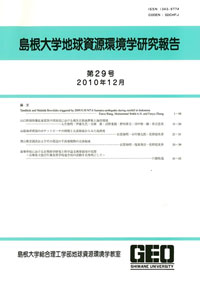島根大学総合理工学部地球資源環境学教室
ISSN:1343-9774

number of downloads : ?
Use this link to cite this item : https://ir.lib.shimane-u.ac.jp/35678
Geoscience reports of Shimane University 34
2016-03-05 発行
島根県大田市仁摩町琴ヶ浜周辺の地質
Geology around the Kotogahama beach, Nima-cho, Oda City, Shimane Prefecture
Hayashi, Hiroki
Department of Geoscience, Interdisciplinary Graduate School of Science and Engineering, Shimane University
Komura, Tetsuya
Graduate School of Shimane University
Ohira, Hiroto
Department of Geoscience, Interdisciplinary Graduate School of Science and Engineering, Shimane University
Sampei, Yoshikazu
Department of Geoscience, Interdisciplinary Graduate School of Science and Engineering, Shimane University
Nomura, Ritsuo
Faculty of Education, Shimane University
Kawano, Shigenori
Tochigi Prefectural Museum
File
Description
The Kotogahama beach in Oda City, Shimane Prefecture is one of the famous singing sand beaches of Japan. We investigated the geology around the Kotogahama beach to clarify the origin and evolution of singing sand. The stratigraphy of the study area is composed of the Miocene Kuri Formation, Plio-Pleistocene Tsunozu Formation, Pleistocene Oe-Takayama Volcanic Rocks, old fan deposits, terrace deposits, Sashimi Formation, and Holocene deposits in ascending order. Among them, the Kuri Formation, which mainly consists of pyroclastic rocks, is most common in the study area. Zircon fission-track dating for the rhyolitic pumice tuff of the Kuri Formation suggested an age of 15.8 ± 0.6 Ma. CNS and microfossil analyses of the muddy layers of the Kuri Formation also suggest that this formation comprises marine and fresh-water deposits. The geologic structure of the Kuri Formation in the Kotogahama area is characterized by a gentle syncline and anticline with a WNW-ESE trend. The shape of the Kotogahama basin corresponds well to the strike of the Kuri Formation. The geomorphology of the Kotogahama beach is primarily controlled by the half-basin structure of the Kuri Formation.
Other Article
PP. xxi - xxiv
PP. 9 - 14
PP. 69 - 75
PP. 89 - 93
